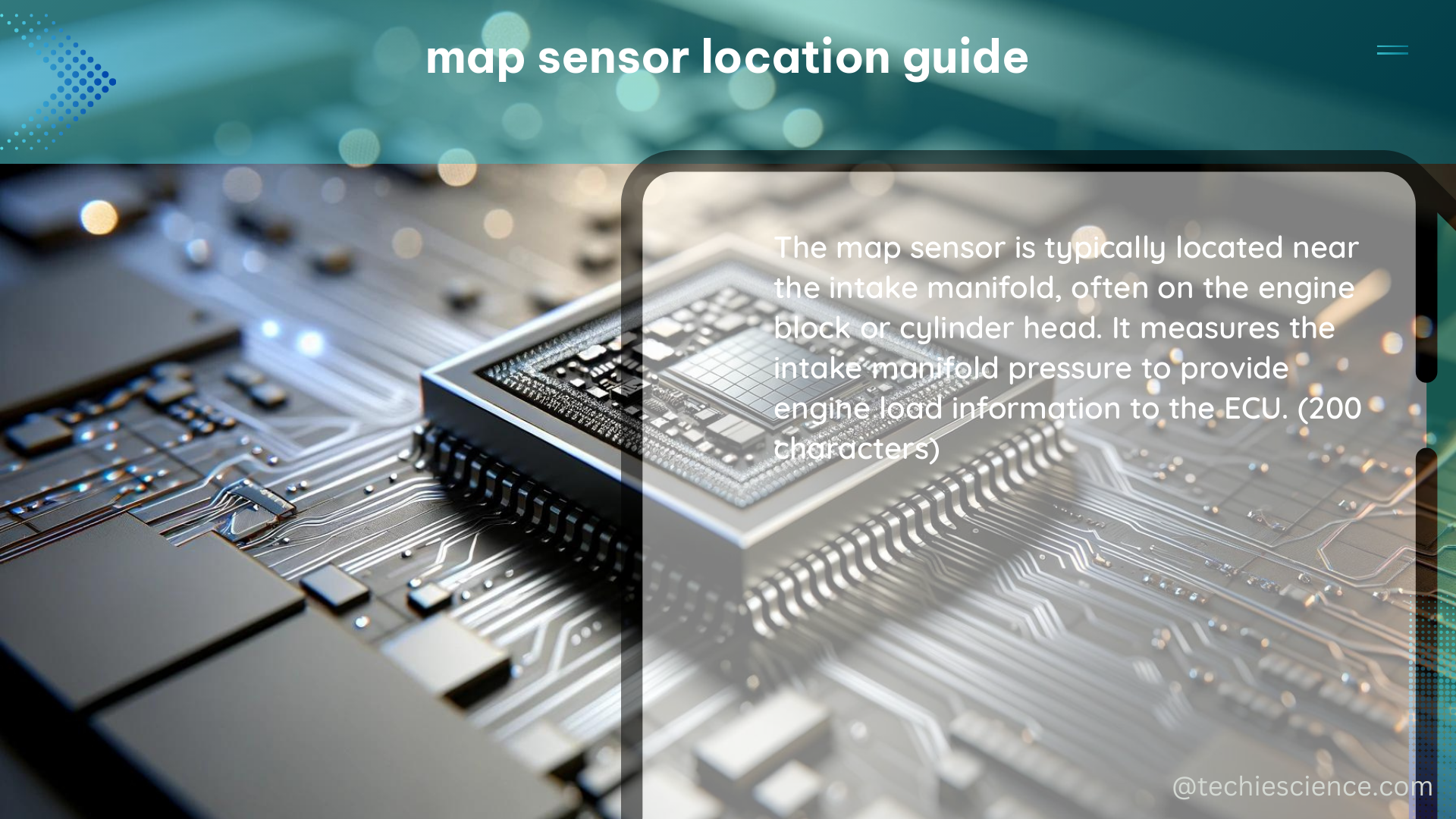The Manifold Absolute Pressure (MAP) sensor is a critical component in modern vehicles, responsible for measuring the pressure inside the engine’s intake manifold. This data is essential for the engine control unit (ECU) to calculate the engine’s load and adjust the air-fuel ratio accordingly. Understanding the precise location and technical specifications of the MAP sensor is crucial for proper diagnosis, maintenance, and optimization of engine performance.
Locating the MAP Sensor: A Detailed Exploration
The location of the MAP sensor can vary significantly between different vehicle models and manufacturers. However, there are some general guidelines to help you identify its position:
- Intake Manifold Proximity: In the majority of cases, the MAP sensor is situated on or near the intake manifold, often in close proximity to the throttle body.
- Turbocharged Engines: In vehicles equipped with turbochargers, the MAP sensor may be located closer to the turbocharger itself, as observed in the Chevrolet Malibu.
- Refer to Service Manuals: For the most accurate and up-to-date information on the exact location of the MAP sensor in your vehicle, always consult the manufacturer’s service manual.
To illustrate the diversity of MAP sensor placements, let’s consider a few examples:
- 2003 Chevy Tracker: The MAP sensor is found on the intake manifold, providing voltage readings that correspond to the manifold pressure.
- Chevrolet Malibu: In this turbocharged model, the MAP sensor is located near the turbocharger, strategically positioned to measure the pressure in the intake system.
Technical Specifications of the MAP Sensor

The MAP sensor operates within a specific set of technical parameters, which are essential for understanding its function and diagnosing any potential issues. These specifications include:
- Voltage Reference Circuit: The MAP sensor utilizes a 5-volt reference circuit, allowing it to operate within a range of 0 to 5 volts.
- Voltage Readings: The voltage reading from the MAP sensor corresponds directly to the pressure inside the intake manifold. This voltage can be translated into units of inches of mercury (inHg) or kilopascals (kPa) for easier interpretation.
- Atmospheric Pressure Indication: In a well-functioning engine, the MAP sensor should display a voltage reading close to 5 volts when the key is on and the engine is off, indicating atmospheric pressure inside the intake manifold.
Diagnosing MAP Sensor Issues
When troubleshooting potential problems with the MAP sensor, it’s essential to consider several factors:
- Electrical Connections: Ensure that the electrical connections to the MAP sensor are secure and functioning correctly. Loose or faulty connections can lead to inconsistent or out-of-range voltage readings.
- Calibration Checks: If the voltage readings are inconsistent or out of the expected range, there may be a calibration issue with the MAP sensor itself. To check for calibration problems, compare the barometric pressure reading with the MAP sensor reading. If the barometric pressure is reasonable, the MAP sensor is likely calibrated correctly.
- Fuel Trim Monitoring: In some cases, a rich condition detected by the oxygen (O2) sensor can feed back to the powertrain control module (PCM), causing it to display long-term and short-term fuel trim as rich. This may indicate a potential issue with the air-fuel mixture, which could be related to the MAP sensor’s performance.
Maintaining the MAP Sensor
Proper maintenance of the MAP sensor is crucial for ensuring its reliable operation and longevity. Unlike the mass air flow (MAF) sensor, which can accumulate dirt on its hot wire, the MAP sensor does not have this vulnerability. However, it’s still essential to keep the sensor clean and free from debris to maintain its accuracy.
If the MAP sensor is faulty and no trouble codes are being set, it’s generally recommended to replace the sensor, as it is a relatively inexpensive component, typically costing between $25 and $60, depending on the vehicle.
Conclusion
The Manifold Absolute Pressure (MAP) sensor is a vital component in modern vehicles, providing critical data to the engine control unit (ECU) for optimizing engine performance and fuel efficiency. By understanding the specific location and technical specifications of the MAP sensor, as well as the proper diagnostic and maintenance procedures, you can ensure your vehicle’s engine is operating at its best. This comprehensive guide has equipped you with the knowledge and tools necessary to tackle any MAP sensor-related challenges with confidence.
References:
- How to Test a MAF or MAP Sensor With a Multimeter – YouTube
- Intro To MAP Sensor Data – YouTube
- MAP sensors | Chevrolet Malibu Forums
- MAP Sensor Diagnosis and Understanding Function- Pt2 – YouTube
- Making sense of your sensors: MAP sensor – Delphi Technologies

The lambdageeks.com Core SME Team is a group of experienced subject matter experts from diverse scientific and technical fields including Physics, Chemistry, Technology,Electronics & Electrical Engineering, Automotive, Mechanical Engineering. Our team collaborates to create high-quality, well-researched articles on a wide range of science and technology topics for the lambdageeks.com website.
All Our Senior SME are having more than 7 Years of experience in the respective fields . They are either Working Industry Professionals or assocaited With different Universities. Refer Our Authors Page to get to know About our Core SMEs.